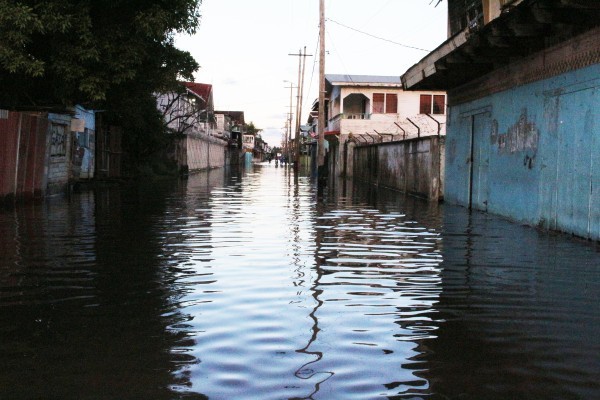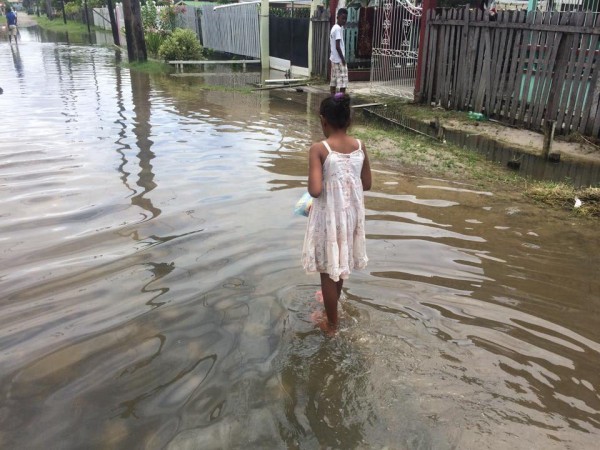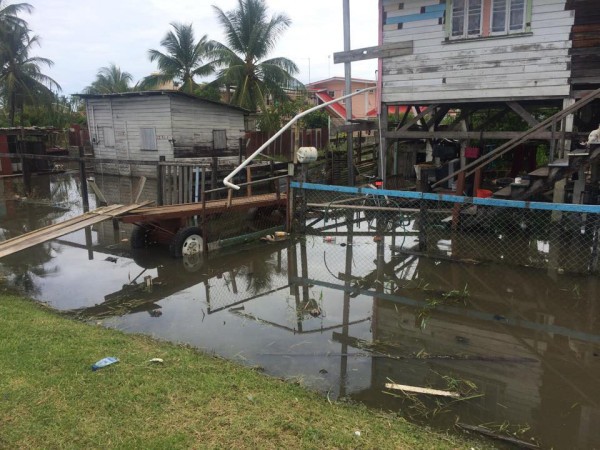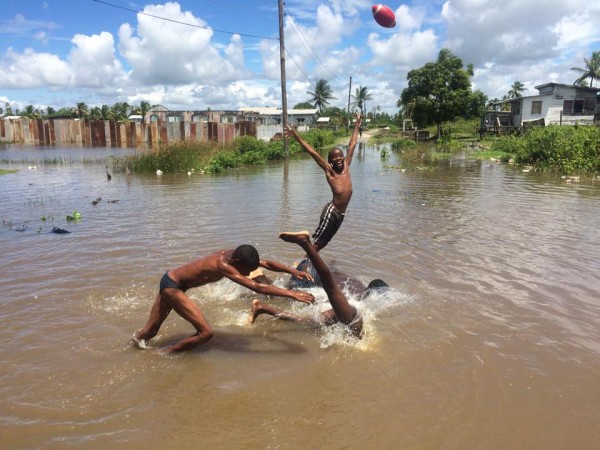Floodwater from Wednes-day’s torrential rain was slowly receding yesterday but some communities on the East Coast have seen no respite even as the government’s relief operation takes shape.
Heavy downpours that started Wednesday afternoon and continued until Thursday morning left the city, East Bank and East Coast area under water. While the water on the East Bank areas had receded yesterday, there was still major accumulation on parts of the East Coast and in Albouystown in the city.
When Stabroek News had visited the Buxton and Annandale communities on Thursday, only parts of the canal had merged with the road along the railway embankment. Yesterday, almost the entire trench had merged with the road. This is likely the result of water from the backlands flowing to the north. On Thursday, about six to eight inches of water covered the yards in the community, while yesterday it was noted that the water had risen to between 12 and 14 inches.
Stabroek News had also visited Better Hope, Industry, Vryheid’s Lust and Chateau Margot on the East Coast, where major flooding was seen. Four to six inches of water had covered most of the yards in the areas and even gushed into residents’ bottom flat houses, destroying furniture and food supplies.
Yesterday, floodwaters still covered most of the yards along the railway embankment road and the inner communities.
Along the railway embankment road at Industry, Balraj Hemraj was forced to endure about 10 inches of water in his yard that seeped into his bottom flat. The man valiantly tried get rid of the water with just a bucket, in a bid to save his poultry feed and food supplies. “I lose nuff, nuff buddy. But what can we do eh? Is not the government fault,” Hemraj said, while noting that he lost 33 ducks to the flood. The man said that other than the 2005 Great Flood, he has never seen the water take so long to recede. “I remember the last time we had the big flood, GuySuCo had their pumps working along with the others. That is what we need right now, more pumps working,” he said.
‘Down under water’
Residents of Albouystown and parts of the East Bank area are also still submerged. They had anticipated a flood due to the torrents of rain but were shocked at the amount of water that had accumulated in just about 12 hours of rainfall.
While water has receded almost completely on the East Bank area, Albouystown is still heavily flooded. When Stabroek News had visited the area on Thursday, two-feet high water was seen in certain parts. Residents of the community had also complained about the defective Sussex Street koker and pump. When Stabroek News visited the koker yesterday, the pump was working but the sluice door was not opened. Royston King, recently appointed Town Clerk, confirmed that the Sussex Street koker was still not working and discussions were in progress to have it up and running as soon as possible.
Barriers that were placed on the main streets of Albouystown to prevent vehicles from passing and sending waves of water through homes were still in place.
When Stabroek News visited yesterday, it was clear that the water had not significantly receded. Residents of the area were still “down under water” and were forced to either face the brunt of the floods, retreat to higher grounds, or utilise the shelters that were set up by the Civil Defence Commission (CDC).
The East Bank has seen the most progress as the water in the most affected areas, such as Diamond and Grove area, had receded completely.
The CDC, the National Emergency Operations Centre (NEOC), and the Ministry of Social Protection have meanwhile opened two shelters in Albouystown to cater for affected residents.
According to Director General of the CDC, Colonel Chabilall Ramsarup, the CDC would be putting measures in place to provide two black tanks to assist in getting clean water to the residents.
In a press release from the Ministry of Presidency, Minister of Governance Raphael Trotman said that although there was almost nine inches of rain in some parts of Georgetown, most of it had receded in less than 48 hours. He praised the amalgamated efforts of various agencies. Reacting to criticism that at least one pump was not working during the low tide, Trotman that while it is in the best interest to have the pumps working 24 hours, like all machinery, they need to be rested, refuelled, and repaired at intervals.
The press release stated that damage assessment teams were sent to various parts of the country. Teams were working from the University of Guyana access road to Coldingen, Melanie to Mahaica, Bel Air to Meadow Bank, and areas on West Coast and West Bank. He said that the teams will be assessing the impact and damage the floodwater has had on homes, health problems being experienced, the levels of nearby canals and the extent of damage to crops, and livestock.
After the assessment is done, a report will be compiled and if needed, a Regional Emergency Operations Centre will be established in regions Three and Four.
The hydromet department has predicted rainfall over the weekend.










